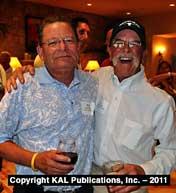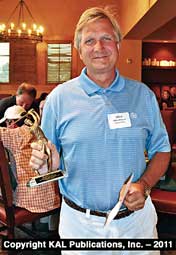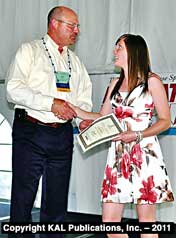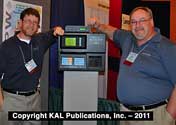

CIOMPAC Destruction Derby


Northern California Petroleum Industry Golf and Tennis Invitational



Washington Oil Energy and Convenience Store Convention
Want to see the photos that didn't make the issue? Check out the Cutting Room Floor.
Coast Oil Combines Operations With SC Fuels
Couche-Tard To Acquire 300+ California
Stations
Banks Show Their Clout As Fed Sets Debit
Swipe
Fee
Holly, Frontier Merger Completed
FDA Displays New Cigarette Health Warnings
SAN JOSE, CA. — SC Fuels, based in Orange, CA., and Coast Oil, based in San Jose, CA., have announced that they have formed Coast Fuels LLC, a wholly-owned subsidiary of SC Fuels.
Mark Mitchell, who had been serving as president of Coast Oil, will serve as president of Coast Fuels. He will report to Steve Greinke, SC Fuels group president.
"These are two of California's oldest petroleum companies joining forces to serve the Northern California market," said Greinke. "As SC Fuels traces its roots back to 1930 and Coast was formed in 1935, both companies have shown a long term commitment to this industry. This combination will leverage our synergies for coverage throughout California. We've had a long relationship with Mark and share similar philosophies and core values. This will be a great fit."
Greinke noted, "We will be combining back room operations and looking for synergies. We're not making any major moves right now. We'll digest this for a bit, keep Coast Fuels up and running and doing well."
Mitchell stated, "This is an exciting opportunity for us to continue the legacy and first-class strengths of Coast Oil. When combined, Coast Oil and SC Fuels will create a powerful alliance. The new Coast Fuels will be able to maintain its long term commitment to its customers."
Mitchell added that, "We can also look for further acquisitions that fit our philosophic and business needs."
MONTREAL, QUEBEC, CANADA — Alimentation Couche-Tard Inc. announced that it has agreed to acquire up to 322 sites along with an additional 65 reseller contracts in Southern California from ExxonMobil. The purchase price for the stations was not disclosed.
According to the company, of the 322 sites, 72 are company-operated and 250 are dealer-owned. Circle K would own the real estate for up to 202 of the total number of sites.
In compliance with California law, ExxonMobil will be presenting an offer to the 165 fee property dealers allowing them the opportunity of first refusal to purchase the property. If any of the properties are purchased by a dealer, however, the branded supply agreement would still be assigned to Circle K.
Couche-Tard noted that the dealer-operated locations would continue to be operated by current dealers.
All of the locations involved in the sale are currently branded Mobil and all will continue to offer Mobil branded fuel and accept the ExxonMobil credit card. However, the company-operated sites will rebrand to the Circle K.
Tim Tourek, vice president operations, West Coast Division, stated, "These stores are high volume, high impact locations. They would significantly strengthen our overall footprint in this important market."
The deal was made through Couche-Tard's Circle K subsidiary and all of the stations will become part of Couche-TardŐs West Coast division network. With the addition of the new sites, Couche-Tard will have 543 company-operated and dealer-operated sites on the West Coast.
The deal is expected to close in stages between the fourth quarter and the second quarter 2012, pending regulatory approval.
WASHINGTON, D.C. — The banks demonstrated the clout they have in Washington D.C. as the U.S. Federal Reserve issued its final rules on debit card swipe fees at the end of June.
"Senator Durbin's interchange fee legislation passed last year as part of the Wall Street Reform bill," explained Sherri Stone, vice president of the Petroleum Marketers Association of America and a legislative advocate for the Petroleum Marketers Association of America on Capitol Hill. "It gave the Federal Reserve the authority to set fees for debit card transactions that are fair and reasonable."
The Fed had issued a proposed rule for the per-transaction debit swipe fee of seven cents per transaction. This was seen as a reasonable profit margin as the Federal Reserve's research determined that the actual cost for processing a debit card swipe was four cents.
As part the political process, a compromise rate of 12 cents per transaction had been proposed and it was believed this rate — although higher than the original proposal — would be the one set forth in the final rules.
Stone noted, "The Federal Reserve has proposed a rule that the swipe fees be between 7 and 12 cents. at 12 cents. This will be 70% lower than the average of last year's transaction fees, which were 44 cents per transaction."
However, at the end of June, the Federal Reserve issued a final rule that set the per-transaction debit swipe fee of 21 cents, significantly higher than the Federal Reserve's originally proposed rate of 7 cents or the compromise rate of 12 cents, an action that came as a surprise to retailers and trade association groups.
The rules also add an additional 0.05 percent of the transaction amount for fraud prevention.
"Final rules should look like proposed rules. This should have been a clear victory for consumers. We are left to believe that the credibility of the Federal Reserve is in question because it's obvious that political pressure from the big banks has impacted the outcome of the final rules," said NACS Chairman Jeff Miller, president Miller Oil Company, Norfolk, VA. "A cap of 21 cents per transaction is better than the current average of 44 cents per transaction, but it is more than 400 percent more than the 4 cents per transaction that the a Fed-sponsored survey of banks found to be the real cost of processing a debit transaction."
In an official statement, the PMAA said, "It is clear from the final rule that the Fed was moved by the banking lobby and political pressure. The rule proposed last year was consistent with the intent of the reforms passed a year ago. PMAA believes the final rule undermines the law and its intended benefits."
They also noted that the Merchants Payments Coalition, a group comprised of retailers across America looking for credit and debit card reform, believes the Fed made "significant concessions to the biggest banks and did not adhere to the intent of law and is considering all available legal options."
The final rules issued at the end of June by the Federal Reserve on debit fees will begin to be implemented October 31. They were originally expected to be finalized by April 21 and implemented by July 21.
DALLAS, TX. — Holly Corporation and Frontier Oil have completed their merger, effective as of July 1, to create a new company, HollyFrontier Corporation.
The companies overcame the final hurdle in the merger at a Frontier Oil stockholder meeting held at the end of June. There Frontier shareholders voted to approve the merger agreement with Holly Corporation, with "aye" votes cast by 99% of the Frontier shareholders at the meeting.
Mike Jennings, Frontier's chairman, president and chief executive officer, stated, "This combination will deliver value for the shareholders of both companies through an expanded asset footprint, reduced costs, increased operational efficiencies and a strong balance sheet. I want to thank our shareholders, customers and dedicated employees for their support throughout this process and look forward to moving forward as an even stronger combined entity."
The new company is headquartered in Dallas, TX., in the former Holly corporate headquarters. Mike Jennings will serve as the president and CEO of the combined company and Matt Clifton, former Holly chairman and CEO, is serving as executive chairman of the combined company. The Board of Directors of HollyFrontier is comprised of seven former Frontier Board members and seven Holly Board members.
HollyFrontier Corporation plans to continue to operate in its existing Southwest, Rocky Mountain, and Mid-Continent territory and will have a refining capacity in excess of 440,000 barrels-per-day from its five refineries.
The value of the combined company is estimated at $7 billion. In accordance with the terms of the merger agreement, Frontier shareholders will receive 0.4811 Holly shares for each share of Frontier common stock that they owned at closing.
In a joint statement, Clifton and Jennings said, "Frontier and Holly are two of the most profitable publicly trade independent refining companies; together we will be one of the largest independent refiners in the U.S." They noted that the combined company "provides significant growth potential via a combined company that is better positioned in an increasingly competitive industry."
HollyFrontier Corporation will be traded on the New York Stock Exchange under the symbol HFC.
SILVER SPRING, MD. — Following the lead of Canada, the U.S. Food and Drug Administration has developed nine gory color images that will be mandated to print on all cigarette packages and advertisements.
The images, which include bodies ravaged by disease, will be paired with text health warnings. The campaign is designed to discourage smoking by graphically displaying tobacco-related diseases and is mandated under the 2009 Family Smoking Prevention and Tobacco Control Act.
One of the images previewed by the FDA is a side-by-side photograph of two sets of lungs. The first pair of lungs appears healthy while the second appears black and ravaged by disease. The written warning below the photo reads "WARNING: Cigarettes cause fatal lung disease." The 1-800-QUIT-NOW telephone number also appears as part of the warning.
These new warnings must take up at least 50% of the front and rear panels of the cigarette packs as well as at least 50% of the front and rear panels of all cigarette cartons.
The photos and text warnings must be incorporated into all cigarette packaging and advertisements within the next 15 months, according to the FDA. Manufacturers must include the new warnings on all cigarettes and advertising beginning Sept. 22, 2012. However, retailers and distributors may sell existing floor stocks of cigarettes bearing the "old" warning label until they are sold out.
Cigarette retailers should note that the "all advertisements" part of the requirement includes "retail or point-of-sale displays (including functional items such as clocks)" as well as coupons, posters, and other advertising materials.
The FDA did specify, however, that "a retailer will not be considered in violation of the rule for publicly displayed advertisements as long as the advertisement contains a health warning, is not created by or on behalf of the retailer (and the retailer is not otherwise responsible for including the health warning), and is not altered by the retailer."
The Petroleum Marketers Association of America noted that they are "concerned that a liability exemption for retailers under the new rule would not extend to POS cigarette display racks that obscure the health warning from the view of the purchaser."
The PMAA is seeking clarification on whether this rule would prohibit such POS cigarette display racks. Stay tuned: the FDA said in the rulemaking that it "will likely address this and other issues in future guidance documents."
Originally published in the August 2011 issue of O&A
Marketing News.
Copyright 2011 by KAL Publications Inc.
Serving the 13 Western States, the World's Largest Gasoline, Oil, Fuel, TBA and Automotive Service Market